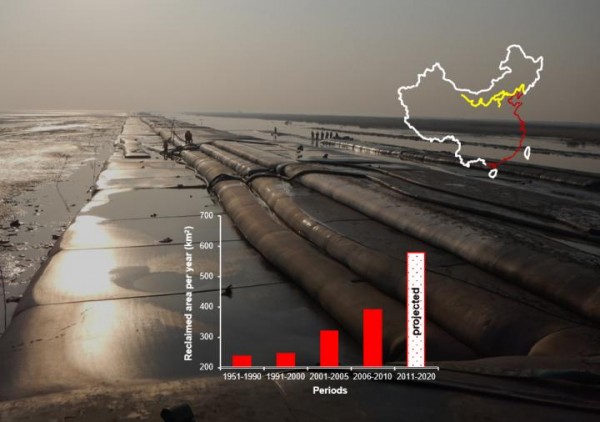Scientists Warn China's New 'Great Wall' Is Anything But
| David Perry | | Dec 05, 2014 07:14 AM EST |
(Photo : Science) China has constructed a sea wall along 50 percent of its coast line, with catastrophic environmental implications.
Heralded as China's second Great Wall, a vast seawall running more than half of the nation's coastline was built for the purpose of reclaiming land from the seabed for development. The environmental impact, however, has created a firestorm of protest from leading ecologists worldwide.
Like Us on Facebook
A group of international sustainability scholars, including Jianguo "Jack" Liu, director of Michigan State University's Center for Systems Integration and Sustainability, in a paper published in November in Science magazine, outline the sweeping downsides of one of China's efforts to fuel its booming economy, downsides that extend beyond China.
While amounting to only 13 percent of China's land area, the coastline contributes to 60 percent of the Middle Kingdom's economy. Its largest economic engines, the cities of Shanghai, Hong Kong, and Shenzhen, are all on the coast. The economic potential has created a push to turn the nation's wetlands into viable real estate.
Yet the scientists of the study, coming from the World Wildlife Fund, Fudan University in Shanghai, and Beijing Forestry University, outline vast ecological costs that do not appear on balance sheets, nor the extreme damage China's coast already suffers. Short-term gain, however, often outweighs long-term effects.
"These coastal areas are a perfect example of coupled human and natural systems. They are also a telling example of how 'telecoupled' our world is," said Liu, who holds the Rachel Carson Chair in Sustainability at Michigan State. "The decisions being made in China are having enormous consequences to people and ecosystem services in China and the rest of the world. We must bring ecosystem services to the business table for a sustainable future."
The Chinese coastlines as they exist now produce 28 million tons of fishery products, nearly 20 percent of the world's total. Looking deeper reveals abundant biodiversity and a support system that also provides other invaluable but underappreciated services for people; wetland ecosystems support a daunting number of birds, millions of which rely on the coastlines as they migrate. More over, coastal wetlands absorb pollutants and carbon and protect people from extreme weather.
Although laws exist to protect China's wetlands, critics contend they lack teeth, and that corrupt local officials look the other way if bribed enough.
Tagswetlands, shore, coast, World Wildlife Fund, Michigan State University
©2015 Chinatopix All rights reserved. Do not reproduce without permission
EDITOR'S PICKS
-

Did the Trump administration just announce plans for a trade war with ‘hostile’ China and Russia?
-

US Senate passes Taiwan travel bill slammed by China
-

As Yan Sihong’s family grieves, here are other Chinese students who went missing abroad. Some have never been found
-

Beijing blasts Western critics who ‘smear China’ with the term sharp power
-

China Envoy Seeks to Defuse Tensions With U.S. as a Trade War Brews
-

Singapore's Deputy PM Provides Bitcoin Vote of Confidence Amid China's Blanket Bans
-

China warns investors over risks in overseas virtual currency trading
-

Chinese government most trustworthy: survey
-

Kashima Antlers On Course For Back-To-Back Titles
MOST POPULAR
LATEST NEWS
Zhou Yongkang: China's Former Security Chief Sentenced to Life in Prison

China's former Chief of the Ministry of Public Security, Zhou Yongkang, has been given a life sentence after he was found guilty of abusing his office, bribery and deliberately ... Full Article
TRENDING STORY

China Pork Prices Expected to Stabilize As The Supplies Recover

Elephone P9000 Smartphone is now on Sale on Amazon India

There's a Big Chance Cliffhangers Won't Still Be Resolved When Grey's Anatomy Season 13 Returns

Supreme Court Ruled on Samsung vs Apple Dispute for Patent Infringement

Microsoft Surface Pro 5 Rumors and Release Date: What is the Latest?













